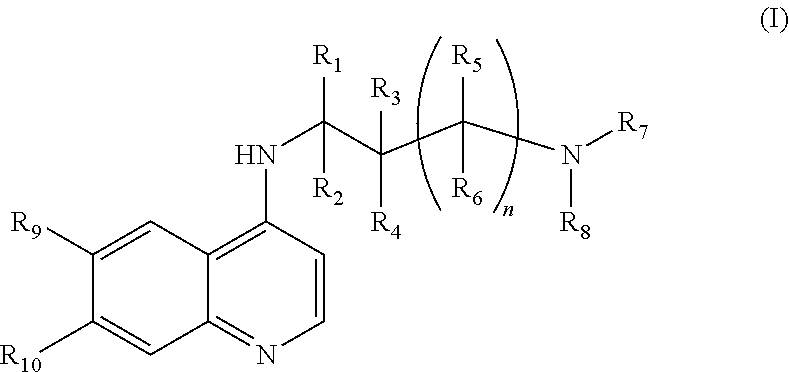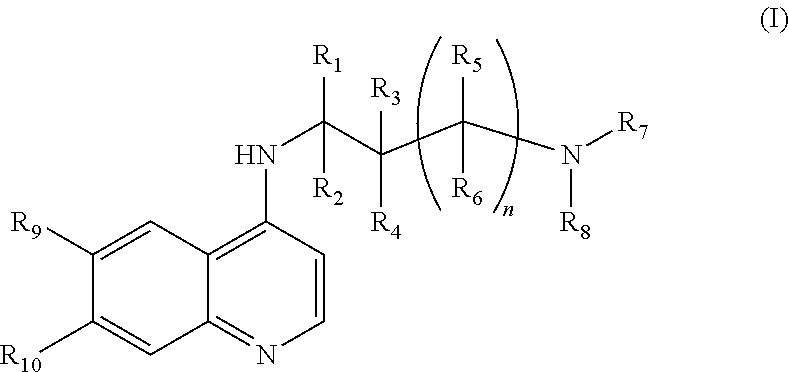Use of chloroquine to treat metabolic syndrome
a metabolic syndrome and chloroquine technology, applied in the field of metabolic syndrome treatment with chloroquine, can solve the problems of increased complex anti-atherosclerosis effect of p53 in dietary models, and limited protective effect, so as to improve the effect of metabolic syndrome, reduce the risk of death from ischemic heart disease, and improve the effect of lipid metabolism
- Summary
- Abstract
- Description
- Claims
- Application Information
AI Technical Summary
Benefits of technology
Problems solved by technology
Method used
Image
Examples
example 1
ATM Mouse Models
Methods
[0116]The ATM mutation was moved into the apoE null mouse model to create an ATM− / − apoE− / − mouse model for evaluating the role of ATM in vascular disease. The apoE null mouse model was described by Plump and Breslow in Annu. Rev. Nutr., 1995, 15:495-518, which is hereby incorporated by reference in its entirety. ATM− / − mice and conditions for breeding are described by Spring, K. et al. in Nat. Genet., 2002, 32(1):185-90, which is hereby incorporated by reference in its entirety. The ATM-deficient mice carry a neo gene to interrupt exon 57 and replace exon 58 of ATM (GenBank Accession No. U55702, SEQ ID NO:2), deleting a region of the p13K domain that is also deleted in a number of individuals with ataxia telangiectasia. Originally in a mixed genetic background (C57BL / 6 and 129Sv), these mice have been backcrossed with BL / 6 mice for more than 6 generations. These backcrossed ATM+ / − mice were intercrossed to obtain ATM deficient littermates or bred with apoE-nu...
example 2
Human Studies
[0172]Subjects meeting the ATP III criteria for the metabolic syndrome have been enrolled and will continue to be enrolled in a study consisting of four limbs to test whether the administration of low dose and very low dose chloroquine to humans activates the ATM-p53 axis and leads to an improvement in the symptoms of metabolic syndrome.
[0173]Subjects between the age of 18 and 55 meet the ATP III criteria for the metabolic syndrome and do not have retinal abnormalities, G6PD deficiency, or certain other major active medical conditions, as described in more detail below. Each has at least three of the following five characteristics: elevated fasting triglycerides (greater than or equal to about 150 mg / dl), low HDL cholesterol (less than about 50 mg / dl in women, less than about 40 mg / dl in men), hypertension (blood pressure greater than or equal to about 130 / 85 mm Hg), increased waist circumference (greater than about 35 inches in women, greater than about 40 inches in me...
PUM
| Property | Measurement | Unit |
|---|---|---|
| time | aaaaa | aaaaa |
| systolic pressure | aaaaa | aaaaa |
| time | aaaaa | aaaaa |
Abstract
Description
Claims
Application Information
 Login to View More
Login to View More - R&D
- Intellectual Property
- Life Sciences
- Materials
- Tech Scout
- Unparalleled Data Quality
- Higher Quality Content
- 60% Fewer Hallucinations
Browse by: Latest US Patents, China's latest patents, Technical Efficacy Thesaurus, Application Domain, Technology Topic, Popular Technical Reports.
© 2025 PatSnap. All rights reserved.Legal|Privacy policy|Modern Slavery Act Transparency Statement|Sitemap|About US| Contact US: help@patsnap.com



